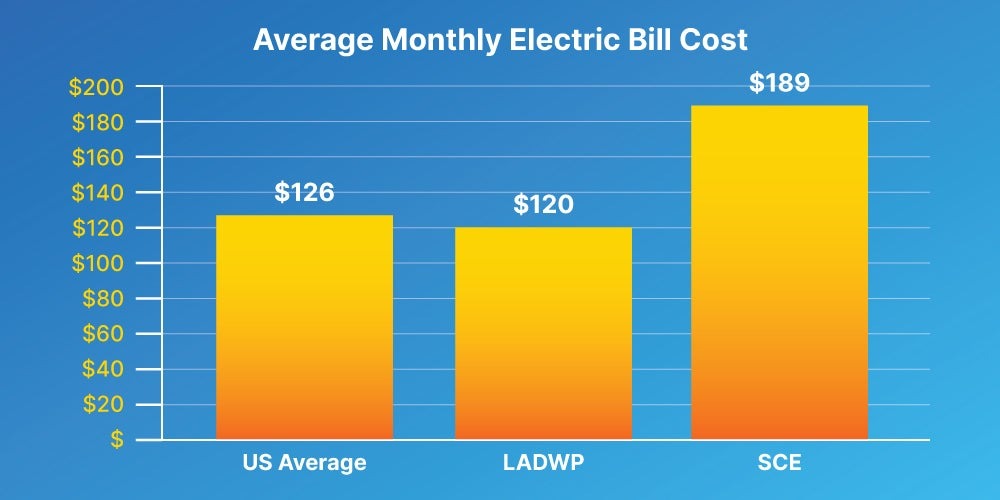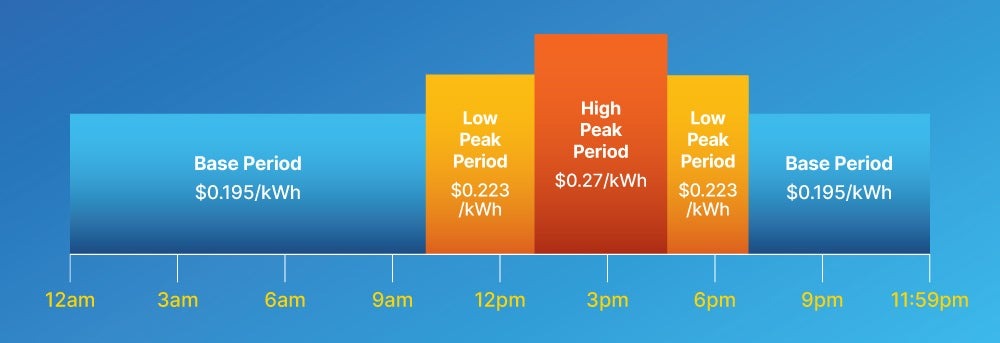Updated 1 year ago
Cost of electricity in Los Angeles: How to save money with LADWP
Written by
Ben Zientara

Find out what solar panels cost in your area
In 2022, the cost of electricity in Los Angeles, CA is 22.1 cents per kilowatt hour (kWh) for the average homeowner.
For customers of the city's largest utility, the Los Angeles Department of Water and Power (LADWP), there is the option to choose between a fixed-rate electricity bill or a time-of-use billing system.
In this article, we’ll give you a better understanding of the rate structure for electricity in LA, ways you can save money, and more.
How do Los Angeles electricity costs compare?
In Los Angeles, residential customers pay much higher rates than people in most of the United States. As of mid-2022, the average cost of electricity across the country is about 14 cents per kWh. That makes LADWP's average rate of 22.1 cents per kWh about 58% higher than average. But LADWP customers are actually fairly lucky: Customers of Southern California Edison (SCE) who live just outside the city pay an average of 29.2 cents per kWh.

The cost of electricity in Los Angeles is between the national average and that of other nearby utilities.
That said, the average Californian uses fewer kWh every month than people across most of the United States. With a relatively mild climate, there is less need for air conditioning, and about half of California homes use natural gas for cooking and water heating, meaning electricity is used mostly for lights, TVs, and small appliances.
Average household electricity usage is about 900 kWh per month across the country, compared to only 545 kWh per month in LADWP territory and 649 kWh per month in SCE territory. These add up to average monthly bills of $126 across the United States, $120 per month for homeowners served by LADWP, and $189 per month in SCE.

Most LA residents pay less than the US average because of low usage. How does your electric bill compare?
Now let’s look at how LADWP rates work and the current rate structure.
How LADWP rates work
There are two kinds of rate plans available to LADWP customers: tiered and time-of-use (TOU). As the names imply, tiered rates have an increased cost per kWh as your usage increases, and the TOU rate has different per-kWh electricity prices based on the time of day energy is consumed.
LADWP Tiered rates
Tiered rates from LADWP (on the R-1A rate schedule) allow people who can keep their monthly or bi-monthly usage low to save money on electricity. The size of the tiers is determined by the microclimate of the region (zone) you live in (see map below) and how often you receive your bill (monthly or bi-monthly). The rate changes by season as well, with significantly higher rates for people who use a lot of electricity during the summer.
The zones are based on the average annual temperature of different parts of the city. Places that are hotter are in Zone 2 and places that are cooler are in Zone 1. People in Zone 2 are allowed to use a little more electricity per tier because of their higher need for air conditioning. Here’s how the Zones look on a map of the LADWP service area:

Here are two tables that show current rates for the various tiers (numbers for 2022) in both Zones:
Tier | Zone 1 monthly (and bi-monthly) allotments | Zone 2 monthly (and bi-monthly) allotments | Price June-September (per kWh) | Price October-May (per kWh) | Monthly Power Access charge |
|---|---|---|---|---|---|
Tier 1 | First 350 (700) kWh | First 500 (1,000) kWh | $0.184 | $0.192 | $2.30 |
Tier 2 | Next 700 (1,400) kWh | Next 1,000 (2,000) kWh | $0.245 | $0.251 | $7.90 |
Tier 3 | Above 1,050 (2,100) kWh | Above 1,500 (3,000) kWh | $0.332 | $0.252 | $22.70 |
TOU rates
Time of Use rates aren't generally recommended, because most homeowners don't want to worry about cutting their energy usage during the early evening hours when they're at home, active, and most in need of things like air conditioning and stovetop cooking. But if you use a very high amount of electricity (say if you charge an electric car at home) or keep odd hours (can reduce your energy usage from 1 pm to 8 pm), they could be a good option.
LADWP's TOU rate plan is called R-1B. It includes a flat $12 monthly service charge and is built using three daily periods called Base, Low Peak, and High Peak. The price of electricity changes based on the period and time of year. Here's how that looks for average prices:

Base Period: Monday through Friday from 8:00 pm to 9:59 am, and all day Saturday and Sunday, with an average price of about 19.5 cents per kWh
Low Peak Period: Monday through Friday from 10:00 am to 12:59 pm and 5:00 pm to 7:59 pm, with an average price of about 22.3 cents per kWh
High Peak Period: Monday through Friday from 1:00 pm to 4:59 pm, with an average price of about 27 cents per kWh
As mentioned above, the price of electricity changes based on the time of year. Specific per-kWh charges can be found here. As you can see, the average per-kWh prices are lower than the top price for Tier 3 energy under rate R-1A. If your home uses a lot of electricity during the summer, you could save some money by switching to R-1B's TOU plan.
How to lower your cost of electricity
The first step to decreasing your energy costs is to examine your usage and see where there might be places to cut. If you haven’t yet done it, switch older incandescent and fluorescent bulbs for LEDs, increase the insulation in your walls, floors, and ceiling, and invest in Energy Star appliances.
But there’s only so far energy efficiency can take you, especially in the modern, connected home. If you plan to add an EV to your life or convert old, polluting gas appliances to electric, your usage will increase, and with it your bill.
The number one way to save money on your LADWP bill is to install home solar panels. Solar panels in California can save a homeowner a ton of money, mostly because of LADWP net metering.
Remember how we pointed out that the cost of electricity in Los Angeles county is 58% higher than the national average? If your home uses electricity for HVAC, water heating, and cooking, your bills are probably REALLY high. Just look at the Tiered rate table above. Let’s just say you live in Zone 1 and use 1,250 kWh one hot summer month. That’s a $325 electricity bill.
Even a small solar system could knock down your usage from 1,250 to 700 kWh, reducing your bill to $170. Your solar panels eliminate the need for Tier 3 energy pricing with almost $15 of that savings coming from reducing your Power Access Charge down to the $7.90 Tier 2 charge.
Adding solar panels to your home can save you hundreds of dollars per year, and because of how much sun LA gets, you don't even need that many solar panels to make a big difference. To get an estimate of how much solar you'll need for your home, how much it might cost and how much you can save, check out our solar panel calculator.
Note: All utility rate calculations are based on data from the Genability Data Explorer unless otherwise noted/linked.
Ben Zientara is a writer, researcher, and solar policy analyst who has written about the residential solar industry, the electric grid, and state utility policy since 2013. His early work included leading the team that produced the annual State Solar Power Rankings Report for the Solar Power Rocks website from 2015 to 2020. The rankings were utilized and referenced by a diverse mix of policymakers, advocacy groups, and media including The Center...
Learn more about Ben Zientara